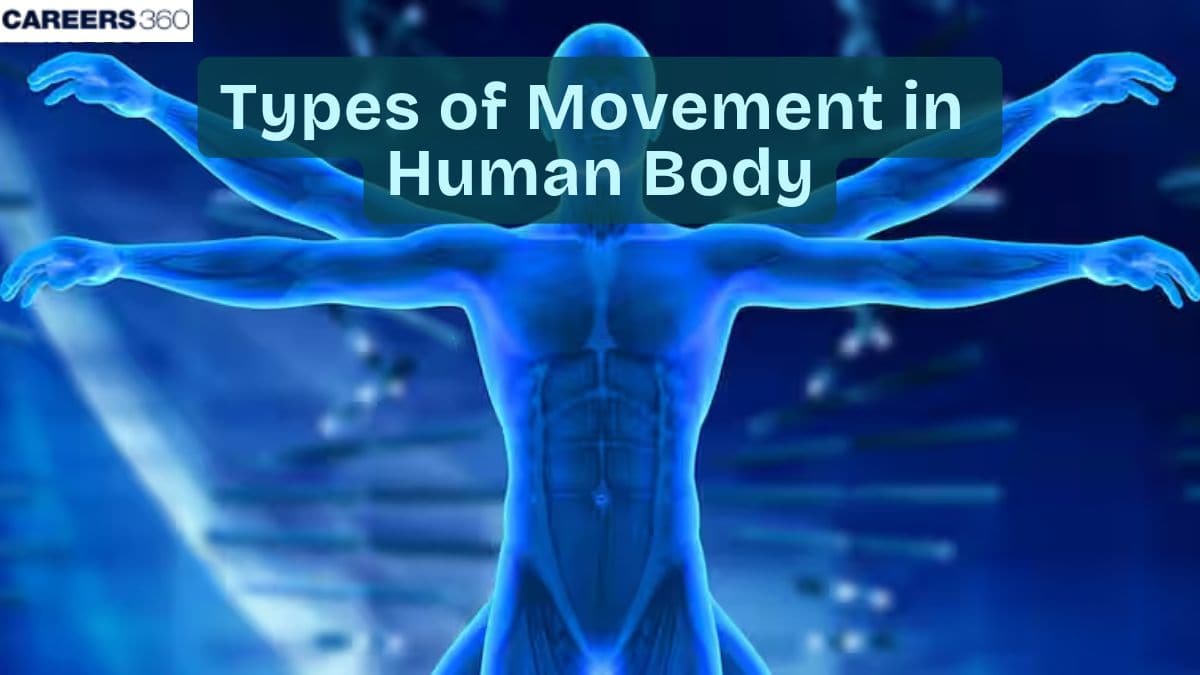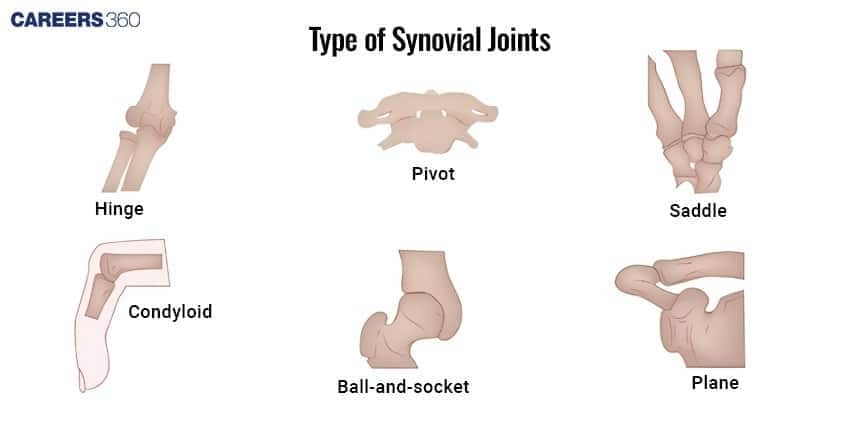Types Of Movement In Human Body: Meaning: Concepts, Types
The human body performs movement through the coordinated action of muscles, bones, joints, and the nervous system, enabling functions such as walking, bending, running, and maintaining balance. Movement is essential for survival, interaction, spatial awareness, and everyday activities. This guide covers organ systems responsible for movement, joint types, mechanisms, disorders, diagrams, FAQs, and NEET-level MCQs.
This Story also Contains
- Why is Movement Necessary?
- Human Body and Its Movement
- Types of Joints in the Human Body
- How Body Systems Coordinate Movement
- Disorders Affecting Movement
- Types of Body Movements NEET MCQs (With Answers & Explanations)
- Recommended Video on the Human Body and Its Movement

Why is Movement Necessary?
Movement is an essential property of all living organisms. It enables survival, interaction, and functioning. Biologically, movement can be described as the process whereby any part of the body, or the whole body, changes position, influenced by powerful muscle contractions through the action of the nervous system.
Human Body and Its Movement
The human body is amazing and can move in so many ways. So here are some key points about how our body moves:
Muscles pull on our bones and make us move. They help us move our arms and legs, too, by contracting in pairs.
Bones give shape to the body. Joints are simply where bones meet, such as knees and elbows help us bend and twist.
The brain sends messages through nerves to control our muscles. This helps in moving smoothly and quickly.
The body knows space location. This allows us to balance and be aware of arms and legs even when the eyes are closed.
This energy to move around is derived from the food we take in, which our body uses to make the muscles function and to keep them active for playing and working.
Types of Joints in the Human Body
Joints are joining points for bones that form articulations moving in different ways styled by their construction and situating
Ball and Socket Joint
It allows rotational movement to occur in the shoulder and hip joints.
Hinge Joint
Allows the movement involving one plane, under the elbow and knee joints.
Pivot Joint
Allows rotational movement around a single axis. The atlantoaxial joint that occurs in the neck.
Gliding Joint
Allows bones to slide past one another, found in wrist and ankle joints.
Saddle Joint
Allows for angular movements similar to a hinge, but with more extremes; found in the thumb joint (carpometacarpal joint).

How Body Systems Coordinate Movement
The body coordinates movement through interaction between the skeleton, muscles and nerves for smooth and efficient movement.
Skeletal System
The skeleton system provides a rigid framework and attachment points for muscles, allowing leverage and support for body movements.
Muscular System
Skeletal muscles use a contract–relax mechanism to produce controlled movement at joints.
Nervous System
The brain sends signals through nerves to muscles to initiate and regulate actions, enabling smooth voluntary movements.
Energy & Metabolism
Food is broken down to form ATP, which supplies the energy necessary for muscle contraction and sustained physical activity.
Disorders Affecting Movement
Many types of disorders can affect movement, thus decreasing quality of life.
Parkinson's Disease
The brain cannot adequately control movement.
Arthritis
Inflammation of joints, causing pain and stiffness.
Muscle Dystrophy
A group of diseases causing progressive muscle weakness.
Types of Body Movements NEET MCQs (With Answers & Explanations)
Important questions asked in NEET from this topic are:
Types of body movement in humans
Biomechanics and functional importance of movements
Practice Questions for NEET
Q1. Passage of ova through the female reproductive tract is facilitated by
Ciliary movement
Amoeboid movement
Flagellar movement
Cyclosis
Correct answer: 1) Ciliary movement
Explanation:
Movements take place within several internal, hollow organs that consist of ciliated epithelium. For example, in the fallopian tubes, ovum transport towards the uterus can be facilitated with the help of cilia movement. In the respiratory tract, the movement of cilia towards mucus, thereby trapping many particles, also facilitates the mucociliary system of clearing such elements from airways. On the other hand, cilia present on the ependymal cells help to circulate cerebrospinal fluid for a balanced fluid environment and nutrient transfer across the brain.
Hence, the correct answer is option 1) ciliary movement.
Q2. Which of the following types of movements is/are not present in the human body?
Amoeboid
Ciliary
Muscular
Somersaultation
Correct answer: 4) Somersaultation
1. Amoeboid Movement: Observed in certain human cells, namely white blood cells (leukocytes). These cells extend pseudopodia for phagocytosis, engulfing foreign entities effectively.
2. Ciliary Movement: Also present within the human framework, it is exemplified by ciliated cells lining the respiratory tract. Here, cilia facilitate mucus and particle expulsion from the pulmonary region.
3. Muscular Movement: This is a ubiquitous phenomenon, integral to the human body. It relies on muscle contractions to enable actions like ambulation and respiration.
4. Somersaultation: Although humans can execute somersaults through voluntary control, typically in contexts such as gymnastics or acrobatics, it does not constitute a natural, physiological movement akin to the former examples. It is not a regular bodily function.
Hence, the correct answer is option 4) Somersaultation.
Q3. Animals like human being can move ________ via activity of muscles
Limbs
Eyelids
Tongue
All of these
Correct answer: 4) All of these
Explanation:
Human beings are endowed with many different limb movements, jaw movements, eyelid movements, and tongue movements. Structure is provided by the skeletal system, but muscles contract and relax to perform activities such as walking, grasping, and speaking. Coordination by the nervous system shows smooth movements, indicating how human beings have evolved so that they function well within their environment, both practically and in gestures.
Hence, the correct answer is option 4) All of these.
Also read-
Recommended Video on the Human Body and Its Movement
Frequently Asked Questions (FAQs)
Flexion decreases the angle between two body parts, such as bending the elbow, while extension increases it, straightening the arm.
The nervous system coordinates movement by sending signals from the brain to muscles via nerves to raise precise and coordinated actions.
Movement disorders include Parkinson's disease, arthritis, and muscular dystrophy. All of these diseases are related to different aspects of muscular and joint functionality.
Ball and socket, hinge, pivot, gliding, and saddle joints provide connections between bones and give way to a variety of movements, thereby offering mobility and flexibility.
Skeletal, smooth and cardiac muscle movements are expressed in the human body, each significant for variable functions and integrated by the nervous system.